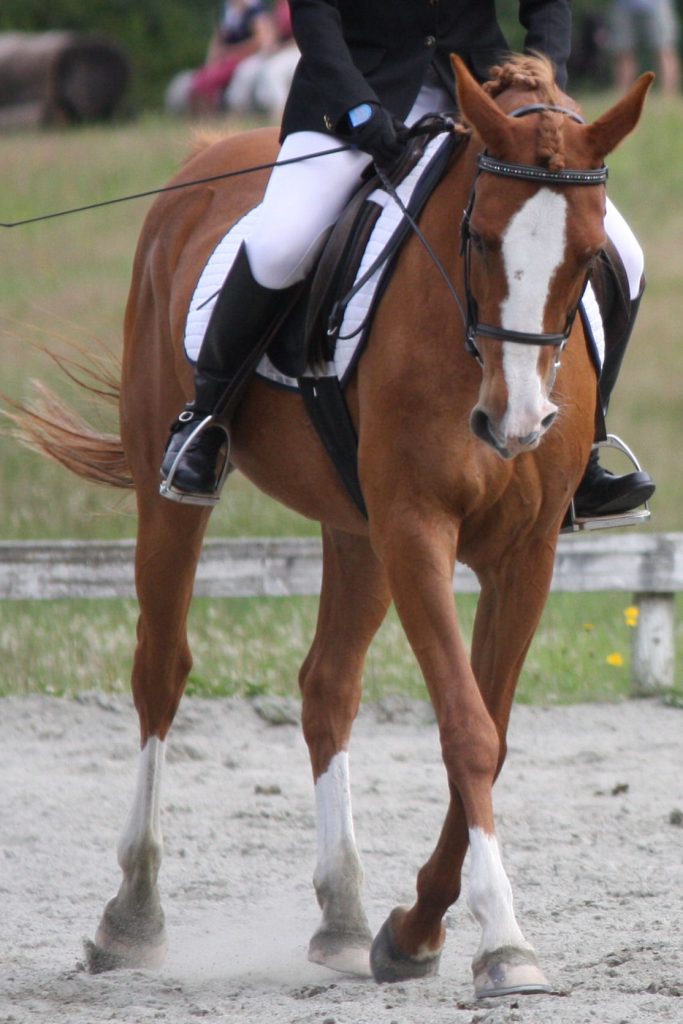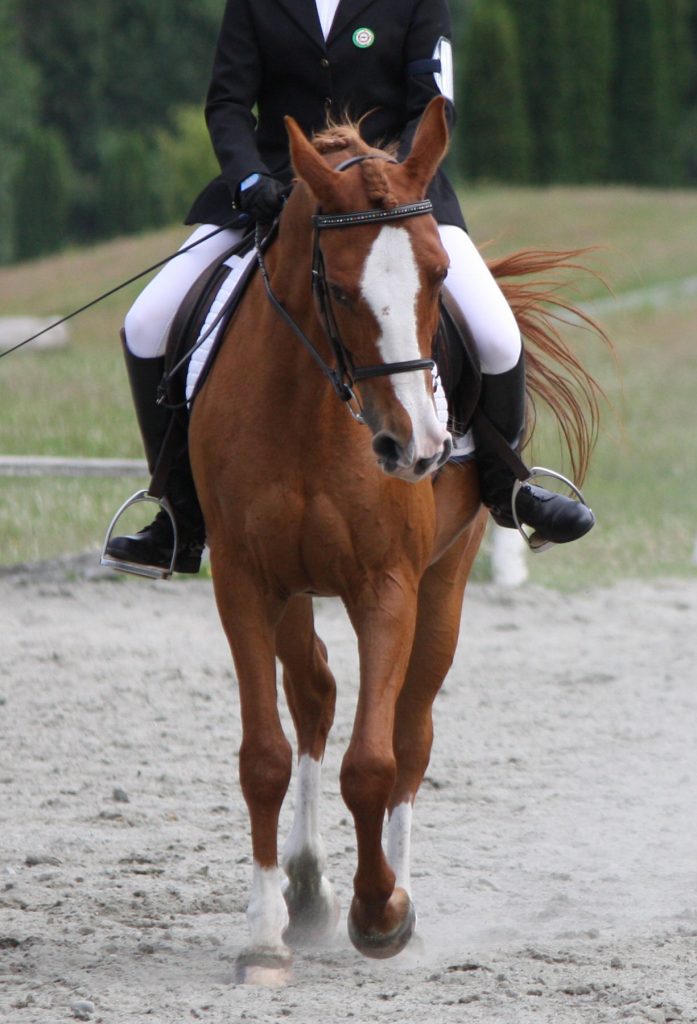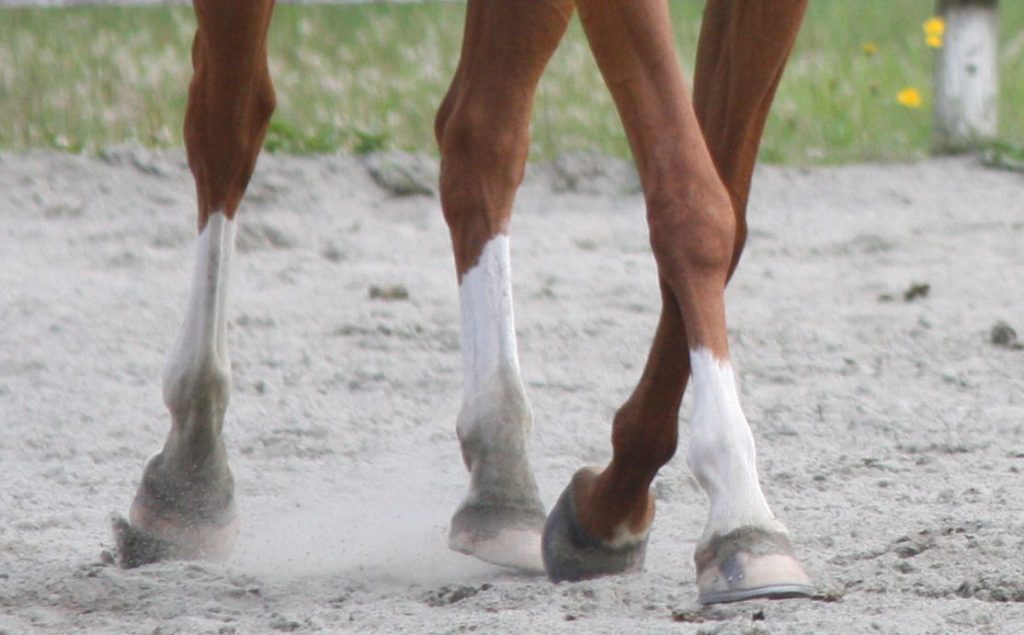Riding Level 4: the Leg Yield
Item 6 of the Level 4 checklist seems quite full:
6. Turns, circles. Trot, canter. Knowledge of canter leads. Leg yield at trot.
However, you already know your turns, circles and canter leads, which you can review in previous posts. At this level, we will be looking for accurate geometry, balance, and control. We do not ask for flying lead changes, so simple changes through trot are expected when changing direction at the canter.
The leg yield is the new item here, and particular to our program. Lateral movements are not asked for in the equivalent Canadian Pony Club C Level (leg yield comes in at C2) or Equine Canada Level 4. However, because lateral movement is so important to mounted combat, we ask that you be able to demonstrate it earlier in your training.
The Leg Yield

The leg yield is a lateral movement in which the direction of travel is both forward and sideways. The horse's body remains parallel with the forward direction of travel, but the inside legs cross in front of the outside legs, taking the horse on a diagonal line.
Most commonly the leg yield is done from the quarter-line or centre-line towards the rail, but it can also be performed as a head-to-the-wall or tail-to-the-wall leg yield, in which the horse travels along with rail with her body at a 30–45-degree angle to the direction of travel. Another leg yield exercise involves spiralling out of a circle.

In the leg yield, the horse is slightly flexed away from the direction of travel. This is opposite to the more advanced half pass, in which the horse flexes in the direction of travel. The leg yield can be done in walk, trot, or canter, but trot is by far the easiest gait in which to achieve it.
Preparing the Leg Yield

Before asking your horse for a leg yield you should be able to
- ask for slight inside flexion. You should be just able to see your horse's eyelashes on the inside, and the neck should have a gentle curve as you look down on it. More flexion than that and you risk your horse popping her shoulder to the outside or swinging her haunches out.
- achieve a softening at the poll and jaw with a half halt. If your horse resists your hands by stiffening her neck and lifting her head she will not be able to lift her back to cross her hind leg underneath her.
- move your horse laterally with your leg. If she doesn't move away from your leg she will leave her haunches behind and just turn to the rail rather than stepping diagonally under herself.
Be sure you can ask for and achieve these responses before attempting the leg yield. They don't have to be 100% perfect all the time, but your horse needs to have an idea of what you want when you ask.
Cueing the Leg Yield

For simplicity we'll only look at one track: from A to M on the left rein. This means you will be turning down the centre line at A, and leg yielding to the right till you reach the rail at M.
- As you approach A on the right rein, supple your horse with a half halt and some inside flexion to prepare an accurate turn onto the centre line.
- Once you are on the centre line, maintain the left flexion from your turn, but do not begin your leg yield yet.
- Allow three or four strides straight down the centre line towards C till you are roughly at D (between K and F).

leg yield right - Slide your left leg slightly back to ask the horse to move his body towards the rail.
- When you reach the rail at M maintain your rhythm and allow your horse to go straight for a few strides before your next movement.
During the leg yield your softening inside (left) hand maintains the flexion, and your outside (right) hand holds firm to prevent the shoulders from popping out. Your outside (right) leg remains neutral at the girth unless you need it to straighten the haunches.
Common errors
- Haunches trailing. This is the most usual error. The horse leaves the haunches behind, and instead of keeping his body parallel to the centre line, simply heads to the rail on a diagonal path. To correct, use more inside leg, possibly further back. You may need to tickle him with a dressage whip behind the inside leg to encourage the hindquarters over. When schooling, if your horse leaves the haunches behind, go straight forward for a stride or two and then ask for the leg yield again.
- Haunches leading. An overly sensitive horse may swing the haunches too far over. In this case keep your inside leg closer to the girth and use a subtler leg cue. Be sure you are holding the shoulder straight with your outside rein and not over-flexing. You may even have to slide your outside leg back momentarily to correct the haunches, but be sure to return it to neutral. Carrying your whip in the outside hand can help as well.
- Popped shoulder. Over-flexing the horse to the inside can cause her to pop her shoulder out and create an angle rather than a curve from withers to poll. Support with the outside rein and leg and be sure you are not being too aggressive with your softening inside hand.
- Loss of rhythm and forward movement. Some horses slow appreciably in the leg-yield. Maintain impulsion with both legs and make sure your hands are not holding your horse back as you ask for bend. Remember the movement should be more forward than sideways.
Every horse you ride will respond differently to your request for a leg yield. It's worthwhile riding a number of different horses to discover this variability for yourself. Some are sensitive and so light off the leg they will practically fly to the wall, while some require what seems to be inordinate inner thigh strength to elicit a single step under the body.
Upcoming Classes
NEW! Ongoing Mounted Combat Classes
 Weekly Mounted Combat Classes have been added to the classes you can attend with regular tuition. These 2-hour sessions focus on the weapons skills needed to progress from Green to Blue Spur. Regular tuition includes classes taken entirely from the ground (no riding skills necessary); a $50/month surcharge applies for those students with riding skills who wish to take part in the mounted section.
Weekly Mounted Combat Classes have been added to the classes you can attend with regular tuition. These 2-hour sessions focus on the weapons skills needed to progress from Green to Blue Spur. Regular tuition includes classes taken entirely from the ground (no riding skills necessary); a $50/month surcharge applies for those students with riding skills who wish to take part in the mounted section.
Sundays noon – 2pm
cost: basic tuition + $50/mo for horse use
instructor: Jennifer Landels
Beginner Riding & Horsemanship
If you’ve never been on a horse, or if it’s been a long time, here’s the place to start. When you arrive at the barn at 11am, you’ll begin with a horsemanship lesson, familiarizing yourself with the horses and their tack, as well as how to groom, handle and tack them up. Then you will have a riding lesson, working through the requirements of Riding Level 1 — the prerequisite to most of the fun stuff we do on horseback!
Sundays 11am – 1pm
12 March – 16 April
cost: $300 + gst for 6 classes
instructor: Stephanie Laversin
Register here, or bundle with Mounted Combat Fundamentals and save $36.
Riding & Horsemanship Level 2

This course is intended for riders who have taken classes through the program and are comfortable tacking up their own horses. Riders should arrive at 9:30am, to tack up and warm up their horses before starting their riding lessons at 10am, followed by Horsemanship Level 2 or 3 lessons at 11am.
Sundays 11am – 1pm
12 March – 16 April
cost: $300 + gst for 6 classes
instructor: Stephanie Laversin
Register here, or bundle with Mounted Combat Fundamentals and save $36.
Riding Level 3+
 This class is intended for independent riders who have achieved Level 2 or higher. Riders are expected to be tacked up and warmed up prior to class. Your own helmets, boots, and half chaps are recommended, as are safety vests for the occasional cross-country class, weather permitting.
This class is intended for independent riders who have achieved Level 2 or higher. Riders are expected to be tacked up and warmed up prior to class. Your own helmets, boots, and half chaps are recommended, as are safety vests for the occasional cross-country class, weather permitting.
Sundays 10am – 11am
12 March – 16 April
cost: $200 + gst for 6 classes
instructor: Stephanie Laversin
Mounted Combat Fundamentals
This 6-week series of classes is intended to give you the basics of swordplay from the ground to prepare you for fighting from horseback. Participants at this level will practise from the ground and the falsemount to achieve the combat skills needed to attain the rank of Green Spur and participate in Mounted Sparring clinics and tournaments. Students who have their Riding and Horsemanship Level 1 and who attend all five classes can reasonably expect to attain their Green Spur by the end of the series. Once you have your Green Spur, you can sign up for Intermediate Mounted Combat, and can spar in our regular Playday event, as well as competing in our annual Carosella tournament.
Sundays 1pm – 3pm
12 March – 16 April
cost: $135 + gst for 6 classes
instructor: Clinton Fernandes
Register here, or bundle with Riding & Horsemanship and save $36.
Mounted Combat Membership
 Our six-month and one-year membership packages are a great way to get more out of the program. With a membership, you get two free practice rides a month, a 10% discount on all Riding, Horsemanship and Mounted Combat courses, a $5 discount on private lessons at Red Colt Co-op, and free weekly Mounted Combat Practice sessions on Monday nights.
Our six-month and one-year membership packages are a great way to get more out of the program. With a membership, you get two free practice rides a month, a 10% discount on all Riding, Horsemanship and Mounted Combat courses, a $5 discount on private lessons at Red Colt Co-op, and free weekly Mounted Combat Practice sessions on Monday nights.
6-month membership, January – June 2017: $200 + gst
1-year membership, January 2017 – December 2017: $300 + gst
To acquire a membership call the front desk at 604 568 9907 or email info@academieduello.com.


